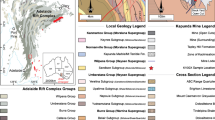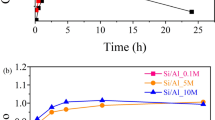Abstract
Calcareous nodules and the surrounding shales were examined by different methods. The comparison of the results was used to draw conclusions about the diagenetic processes.
The mineral components of the nodules and of the surrounding shales are qualitatively the same: besides carbonates mainly quartz, plagioclase, potassium-feldspar, muscovite and chlorite. As well in the nodules as in the shales, quartz and plagioclase show new formations together with signs of partial solution (indented grain boundaries).
Differences are found in the quantitative composition of the nodules and of the corresponding shales: besides a much higher amount of calcite, the nodules contain more quartz and plagioclase than the shales. The shales contain more clay minerals. The chemical analysis shows that the shales contain more titanium than the insoluble residue of the nodules.
The following diagenetic processes are observed: the partial solution of quartz and plagioclase is more pronounced in the shales than in the nodules. This observation is confirmed by the difference between the maxima of the grain size distribution curve of these minerals in the nodules and in the shales. It is, furthermore, confirmed by the relative enrichment of titanium in the shales. Besides, new formations of chlorite are found in the outer zones of the nodules and in the shales. These formations have a higher index of refraction and a higher Fe-content than the detrital chlorite. Their thermic stability is, however, lower. An increase of potassium in muscovite-illite in the course of the diagenesis is observed (in the nodules, muscovite-illite contains about 8% K2O, in the shales about 10% K2O). All these transformations occur more slowly in the middle of the nodules than near their surface.
Zusammenfassung
Mit Hilfe der verschiedenen Untersuchungsmethoden. wurde versucht aus einem Vergleich von Kalkknollen und den sie umgebenden Tonschiefern Rückschlüsse auf die diagenetischen Vorgänge zu ziehen.
Der qualitative Mineralbestand ist in den Geoden und in den Schieferproben der gleiche: Neben dem Carbonat treten hauptsächlich Quarz, Plagioklas, Kalifeldspat, Muskovit und Chlorit auf. Quarz und Plagioklas zeigen in Knolle und Schiefer neben Hinweisen auf Neubildung stark gezackte Ränder, die auf Anlösung deuten.
Im quantitativen Gehalt treten Unterschiede zwischen Knolle und Schiefer auf: Abgesehen vom wesentlich höheren Calcitgehalt enthalten die Geoden mehr Quarz und Plagioklas als die Tonschiefer. Für die Schiefer wurde ein, größerer Tonmineralgehalt festgestellt. Aus der chemischen Analyse ergibt sich, daß die Schiefer mehr Titan enthalten als die Knollen.
Es lassen sich folgende diagenetische Vorgänge erkennen: Quarz und Plagioklas wurden im Schiefer stärker angelöst als in der Knolle. Dieses wird bestätigt durch das unterschiedliche Maximum der Korngrößenverteilung dieser Minerale in den Geoden- und Tonschieferproben und durch die relative Anreicherung von Titan im Schiefer. Weiterhin wird Chloritneubildung am Knollenrand und im Schiefer beobachtet. Dieser besitzt eine höhere Lichtbrechung und größeren Fe-Gehalt und ist thermisch instabiler als der detritische Chlorit. Für Muskovit-Illit wird die Zunahme des Kaliumgehaltes in den Schiefern während der Diagenese festgestellt. In den Kalkknollen enthält er etwa 8% K2O, in den Schiefern aber etwa 10%. Alle diese Veränderungen gehen in den Knollenmitten am langsamsten vor sich.
Similar content being viewed by others
Literatur
Biltz, W., u. H. Biltz: Ausführung quantitativer Analysen. Stuttgart: Hirzel 1955.
Brindley, G.W., and F.H. Gillery: X-ray identification of chlorite species. Am. Mineralogist 41, 149–186 (1956).
Brown, G.: The X-ray identification and crystal structures of clay minerals. Miner. Soc. London 1961.
Correns, C.W.: Die Sedimente des äquatorialen Atlant. Ozeans. Deutsche Atlant. Expedition Meteor 1925–1927. Wiss. Ergeb.Bd. III, Teil 3. Berlin u. Leipzig: W. de Gruyter & Co. 1937.
—: Zur Geochemie der Diagenese. Geochim. et Cosmochim. Acta 1, 49–54 (1950).
—, u. W. Schott: Vergleichende Untersuchungen über Schlämm- und Aufbereitungsverfahren von Tonen. Kolloid-Z. 61, 68–80 (1932).
Füchtbauer, H.: Die nichtkarbonatischen Bestandteile des Göttinger Muschelkalkes mit besonderer Berücksichtigung der Mineralneubildungen. Beitr. Mineral, u. Petrog. 2, 235–254 (1950).
-, u. H. Goldschmidt: Beobachtungen zur Tonmineraldiagenese. 41369-International Clay Conf. 1963, S. 99–111.
Hegemann, F., u. H. Thomann: Spektralphotometrische Verfahren bei der Tonanalyse. Ber. dtsch. keram. Ges. 37, Heft 4, 127–136 (1960).
Hey, M.H.: A new review of the chlorites. Mineral. Mag. 30, 277–292 (1954).
Hillebrand, W.F., and G.E.F. Lundell: Applied inorganic analysis. New York: John Wiley & Sons 1955.
Jasmund, K.: Die silikatischen Tonminerale. Weinheim: Verlag Chemie GmbH 1955.
Klug, H.P., and L.E. Alexander: X-ray diffraction procedures (for polycrystalline and amorphous materials). New York: John Wiley & Sons 1954.
Kraume, E., u. K. Jasmund: Die Tufflagen des Rammelsberges bei Goslar. Beitr. Mineral. u. Petrog. 2, 443–454 (1951).
Lippmann, F.: Anwendungsmöglichkeiten der Guinier-Kamera nach v. Wolff bei der röntgenographischen Tonuntersuchung. Beitr. Mineral. u. Petrog. 4, 251–254 (1954).
—: Ton, Geoden und Minerale des Barrême von Hoheneggelsen. Geol. Rundschau 43, 475–503 (1955).
Logvinenko, N.V., and V.G. Kosmachev: The predistribution of certain minor elements during the diagenesis of deposits of the Taurian Series of the Crimea. Dokl. Acad. Sci. USSR 135, 1078–1080 (1961).
Mackenzie, R.C.: The differential thermal investigation of clays. Mineral. Soc. London 1957. Aberdeen: Central Press 1957.
Petruck, W.: Determination of the heavy atom content in chlorite by means of the X-ray diffractometer. Amer. Mineralogist 49, 61–71 (1964).
Pilkey, O.H., and H.G. Gooden: Trace elements in recent mollusk shells. Limnology and Oceanography, vol. 8, No. 2, 137–148 (1963).
Schoen, R.: Semi-quantitative analysis of chlorites by X-ray diffraction. Amer. Mineralogist 47, 1384–1392 (1962).
Schwarzenbach, G.: Die komplexometrische Titration. Stuttgart: Ferdinand Enke 1957.
Seibold, E.: Kalk-Konkretionen und karbonatisch gebundenes Magnesium. Geochim. et Cosmochim. Acta 26, 899–909 (1962).
Shapiro, L., and W.W. Brannock: Rapid analysis of silicate, carbonate and phosphate rocks. Geol. Survey Bull. 1144-A (1962).
Silica in sediments (Symposium): Soc. Econ. Pal. Min. spec. publ. No. 7 (1959).
Singh, S., and K.P. Gupta: A rapid method of the estimation of calcium and magnesium carbonates in limestones, dolomite and other calcareous materials. Z. anal. Chemie 206, 5–8 (1964).
Tröger, W.E.: Optische Bestimmung der gesteinsbildenden Minerale, Teil I. Stuttgart: E. Schweizerbart 1959.
Walger, E.: Zur mikroskopischen Bestimmung der gesteinsbildenden Karbonate im Dünnschliff. Neues Jahrb. Mineral. Monatsh. 182–187 (1961).
Weaver, C.E.: Potassium content of illite. Science 147, No. 3658 (1965).
Author information
Authors and Affiliations
Additional information
Meinem verehrten Lehrer, Herrn Prof. Dr. Dr. h. c. C.W. Correns danke ich herzlich für die Förderung in meinem Studium, für die Stellung des Themas und für allen Rat, den er mit bei der Ausführung dieser Arbeit zuteil werden ließ.
Herrn Prof. Dr. K. H. Wedepohl und Frau Dr. P. Schneiderhöhn danke ich für sehr anregende Diskussionen.
Ferner sei allen Angehörigen des Geologischen Instituts der Universität Göttingen gedankt, die mir bei der Probenbeschaffung behilflich waren.
Ebenso danke ich allen Angehörigen des Mineralogischen. Instituts, die zum Gelingen der Arbeit beitrugen.
Rights and permissions
About this article
Cite this article
Knoke, R. Untersuchungen zur Diagenese an Kalkkonkretionen und umgebenden Tonschiefern. Contr. Mineral. and Petrol. 12, 139–167 (1966). https://doi.org/10.1007/BF00518405
Received:
Issue Date:
DOI: https://doi.org/10.1007/BF00518405




